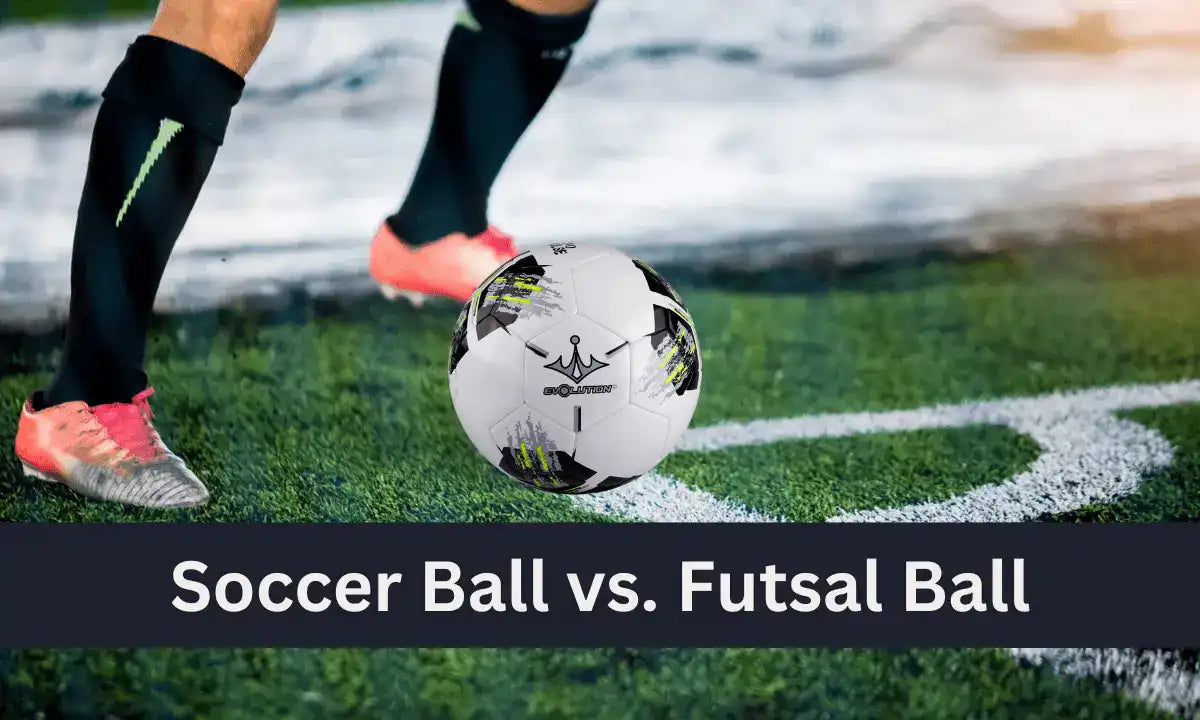Futsal Ball vs Soccer Ball – Which One Improves Your Skills Faster?

If you’ve ever trained in football (soccer), you’ve probably wondered: Should I practice with a futsal ball or stick to a regular soccer ball? This debate has existed for years among players, coaches, and even professional trainers. Both balls serve unique purposes, but when it comes to improving skills faster, the choice can make a huge difference.
At Evolution Sports, we understand that the right equipment isn’t just about performance, it’s about unlocking your potential. In this article, we’ll break down the differences between futsal and soccer balls, highlight their unique benefits, and guide you on which one truly accelerates your skill development. By the end, you’ll have the clarity to choose the ball that suits your goals best.
What Is a Futsal Ball?
A futsal ball is smaller, heavier, and designed for indoor futsal matches played on hard courts. The official size is usually Size 4, and unlike a standard soccer ball, it has a reduced bounce. This means it stays closer to the ground, making control and precision a priority.
-
Size: Usually Size 4 (smaller than a Size 5 soccer ball).
-
Weight: Slightly heavier, making it less bouncy.
-
Purpose: Designed for tight spaces and fast-paced indoor play.
-
Key Skill Impact: Forces you to focus on quick touches, ball control, and sharp passing.

What Is a Soccer Ball?
A soccer ball (also called a football globally) is what you see in traditional outdoor 11-a-side matches. The official professional size is Size 5, and it’s lighter with a higher bounce compared to a futsal ball.
-
Size: Size 5 (standard for adults and professionals).
-
Weight: Lighter compared to futsal balls.
-
Purpose: Built for outdoor pitches, grass, or turf.
-
Key Skill Impact: Helps improve long passing, shooting power, and aerial control.
Futsal Ball vs Soccer Ball: Key Differences at a Glance
| Feature | Futsal Ball 🏐 | Soccer Ball ⚽ |
|---|---|---|
| Size | Size 4 | Size 5 |
| Weight | Heavier | Lighter |
| Bounce | Low | High |
| Playing Surface | Indoor courts | Outdoor fields |
| Best For | Ball control, short passing, fast reactions | Shooting, long passes, outdoor performance |
| Skill Focus | Technique, dribbling, precision |
Power, endurance, tactical play |
How a Futsal Ball Improves Your Skills Faster
Using a futsal ball is like practicing football on “hard mode.” Its design forces you to:
-
Develop Quick Reflexes – With less bounce and a smaller playing surface, you must think and react faster.
-
Improve Close Control – The heavier weight means sloppy touches get punished, helping refine your dribbling skills.
-
Master Ground Passing – Since the ball stays closer to the ground, you naturally focus on crisp, accurate passes.
-
Enhance Tactical Awareness – Futsal demands constant movement and teamwork, sharpening decision-making under pressure.
In short, futsal is perfect for players who want to sharpen technical skills, dribbling, precision passing, and fast ball control.
How a Soccer Ball Improves Your Skills Faster
Soccer balls, on the other hand, are essential for outdoor game mastery. Training with them allows you to:
-
Boost Shooting Power – The lighter ball helps you practice volleys, free kicks, and long-distance strikes.
-
Master Aerial Skills – Headers, long passes, and goal kicks are only possible with a standard soccer ball.
-
Enhance Endurance – Outdoor games require stamina, so playing with a soccer ball builds fitness and adaptability.
-
Improve Tactical Play – Full-sized fields teach spacing, vision, and reading the game on a larger scale.
For players aiming to succeed in 11-a-side football, the soccer ball is non-negotiable.

Which One Actually Improves Skills Faster?
The honest answer: Both, depending on your goals.
-
If your goal is technical mastery (tight control, passing accuracy, quick decision-making), a futsal ball accelerates progress.
-
If your goal is real-match performance (shooting, fitness, tactical awareness), a soccer ball is essential.
In fact, many professional players, including legends like Cristiano Ronaldo and Neymar, grew up playing futsal before transitioning to soccer. The combination made them complete players with both finesse and power.
Pro Training Tip: Use Both for Maximum Results
The best strategy isn’t choosing one, it’s using both. Here’s how you can structure your training:
-
Weekdays (Indoor/Futsal Ball): Focus on dribbling drills, close passing, and small-sided games.
-
Weekends (Soccer Ball): Train outdoors with shooting, long passes, and match simulations.
By alternating, you’ll build a skill set that covers both technical sharpness and match fitness.
Why Buy Your Ball from Evolution Sports?
At Evolution Sports, we don’t just sell balls, we help players elevate their game. Whether you’re looking for a high-quality futsal ball to refine your close control or a durable soccer ball for outdoor matches, our products are:
-
✅ Durable: Built to withstand intense training and match conditions.
-
✅ Performance-Tested: Designed to help you improve faster.
-
✅ Player-Approved: Trusted by coaches, teams, and aspiring players.
When you buy from Evolution Sports, you’re not just getting equipment, you’re investing in your football journey.
Final Thoughts
When it comes to futsal ball vs soccer ball, the truth is both have unique strengths, futsal sharpens close control and quick decision-making, while soccer balls prepare you for outdoor power, endurance, and real-match scenarios. The smartest players use both to become well-rounded athletes, combining technique with performance. At Evolution Sports, we make this journey easier by providing high-quality futsal and soccer balls designed to last, perform, and help you improve faster. Whether you’re training indoors or outdoors, choosing Evolution Sports means choosing growth, durability, and confidence every time you step on the field.
FAQs
1. Can a futsal ball replace a soccer ball in training?
No. A futsal ball is great for close control but doesn’t prepare you for outdoor match conditions. Both should be used for well-rounded development.
2. Is a futsal ball heavier than a soccer ball?
Yes. It’s slightly heavier and has reduced bounce, forcing better ground play.
3. What size soccer ball should kids use?
-
Ages 3–7: Size 3
-
Ages 8–12: Size 4
-
Ages 13+: Size 5
4. Why do professionals recommend futsal training?
Because it sharpens reflexes, decision-making, and close ball control—skills that transfer to outdoor football.
5. Which ball should I buy first as a beginner?
If you’re focused on playing outdoor matches, start with a soccer ball. But if you want to build strong fundamentals, investing in both is ideal.
